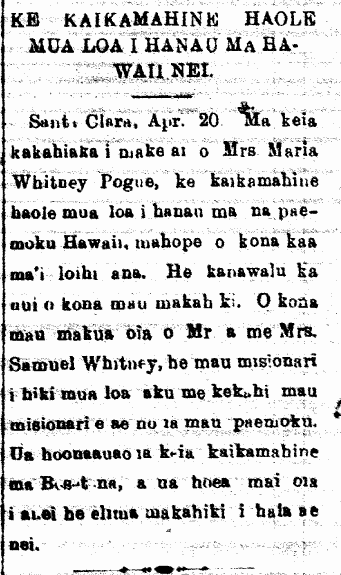Barely survived at sea
O Kuokoa Newspaper; Aloha oe:—Perhaps you and your Editor can be tolerant and include this in a Column of your entire stout body, about a crisis at sea, like this: Several skiffs left Niihau for Kauai, in Hanalei, to peddle goods; they did not face the crisis during this trip because the winds were calm on the sea, however, the next week they made ready to return, that being Thursday, the 12th of May, but because the wind was growing stronger, it wasn’t appropriate to continue the travels, therefore they landed at Nualolo that day, and stayed there for those days; and on Saturday, the 14th, they made to return here to Niihau while knowing the activity of the wind was bad; perhaps it was because they felt that the skill of the Niihau youth would not be acclaimed should they return in the calm, so they were worked up to sail, but after leaving and reaching the middle of the deep seas of Kaulakahi, one of the skiffs was pounded by a billow, and it overturned, and they were in dire straits. And when the second skiff noticed that this one had sunk, they threw their belongings into the sea and went to save the lives of the people overcome by calamity. The number of people aboard that vessel that had sunk was 13 including a small, young child who wasn’t yet crawling; I felt sorrow when I heard of this tragedy.
I strongly believe that if it wasn’t for the second skiff, and there was but just one skiff returning from Kauai, and they ran into this trouble, then they would be all gone, being swallowed by the belly of the ocean, and which of them would have escaped to be the messenger, the one to tell us of this sinking? I don’t think any one of them. And here is another thing; should none of them have lived, then we would have imagined something that was not true: “They are there living on Kauai;” but when some people from Kauai came and heard of them: “They left a long time ago.” Then what would we have then? Just this, the word that they had died, while accepting that fish, an alamihi.”¹
Here is another thing; being that I believe they have relatives on Kauai, along with other places of these islands, who are full of wonder, asking, “who are these Niihau people who were in trouble, and were they saved by the second skiff” So your friend will give each of their names, and here they are: Kaaukuu, Kalana, Kepuoiki, Kawala, Kaika, Mahuiki, Puni, and Kaikuahine, who are men; and Kamupoloula, Kamakahuilama, and Puuiki, who are women; and the small children and a man named Limaiole; those are the names of each of them in the skiff that sank. These are the names of the people aboard the skiff which saved them: Moopuna, Kamalikehakeao, Kaoku, Kaneiolouma, Kehau, and Kalauakaino, who are men; and Kewa and Niihau, who are women. The total number of them all was 22. And with this saving of these people from death, I recall an old saying: “Life is blessed through God, your snicker was almost fitting for me. [?? “Pomaikai ke ola na ke Akua, mai ku no ko aka-iki ia’u.”
As for the skiff that sunk and all of their cargo, it is all gone into the depths of the ocean, and all that was left are their lives, and what they had on; and God was patient with them and they landed on the east side of Niihau nei, in the place called Kii.
These people, some of them were of the Catholic faith, and some were Protestants. These people nearly grabbed onto the club of Kekuaokalani, “Hoolehelehekii,”² along with my father-in-law, “Laumihi,”³ as they set off in strong winds; what’s wrong with staying put until it is calm and then get up and come back. It is in man’s nature to show off, thinking that he will be famous for his prowess at sailing. You are competent facing a fraction of the wind, but should the ferocity of the wind be greater than your skill, then I believe that your intelligence would not leave you victorious. “Praise god in the high heavens, peace on earth, and good will towards men.” With aloha,
P. R. Holiohana.⁴
Kihalanui, Niihau, May 21, 1864.
¹A play on alamihi crab which can also sound like “path to repentance”.
²A play on the name “Hoolehelehekii,” meaning to be all talk.
³A play on the name “Laumihi,” perhaps meaning much remorse.
⁴P. R. Holiohana is most likely also known as P. R. Holi.
[On a related note, please don’t drive if you have been drinking. It isn’t worth the risk you are putting yourself and others on the road in.]
(Kuokoa, 6/18/1864, p. 4)

Ka Nupepa Kuokoa, Buke III, Helu 25, Aoao 4. Iune 18, 1864.










